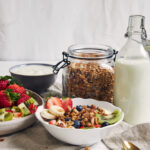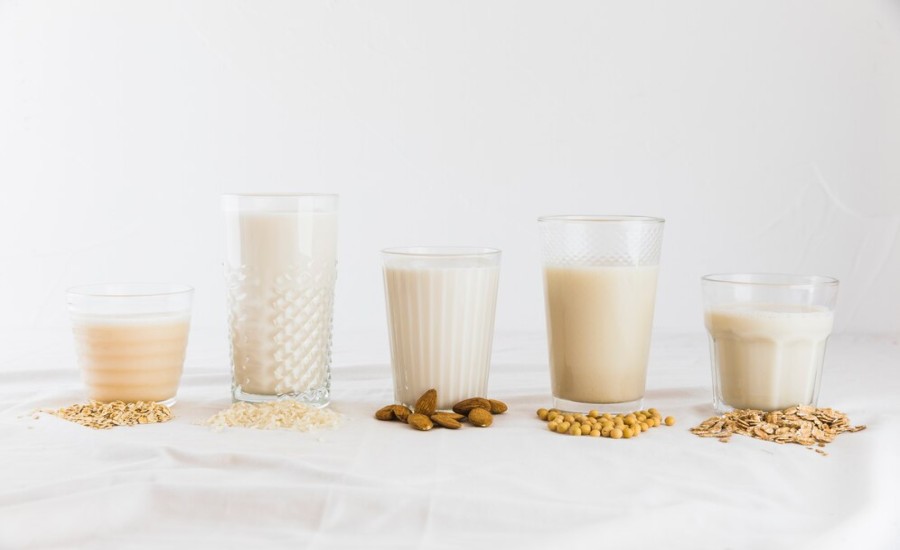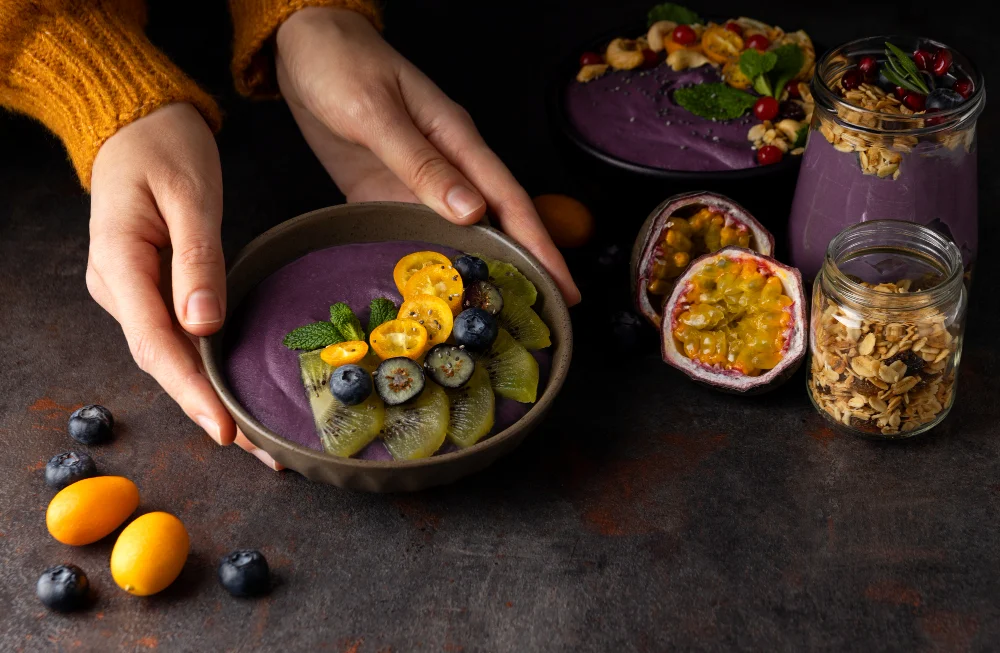The plant-based milk market has transformed dramatically from a niche alternative to a mainstream staple, revolutionizing how we think about “milk” in the modern diet. This comprehensive analysis examines dairy alternatives through multiple perspectivesnutritional science, environmental impact, market trends, and culinary applications—offering a holistic understanding of how plant-based milks fit into our food system. From traditional soy and almond to innovative newcomers like potato and barley milk, the multidimensional benefits of plant-based alternatives represent a convergence of nutritional science, environmental consciousness, culinary innovation, and market evolution that continues to reshape our relationship with this fundamental food category.
Nutritional Crossroads: Where Plant Power Meets Dietary Needs
Once viewed as merely a solution for the lactose intolerant, plant-based milks have evolved to become nutritional powerhouses in their own right. The market has responded to consumer demand for products that not only mimic dairy milk’s functionality but also offer distinct nutritional benefits tailored to various health goals and dietary preferences. This analysis explores how plant-based milks have transcended their substitute status to become innovative food products that address numerous nutritional, ethical, and environmental considerations in our daily diet.
Best Plant Based Milks For Health
LENS 1: The Nutritionist’s View

The Nutritional Evolution of Plant Milks
“Plant-based milks have come a long way nutritionally,” explains Dr. Maya Johnson, registered dietitian specializing in plant-based nutrition. “Many early alternatives lacked the protein, calcium, and vitamin content of dairy milk, but today’s options are increasingly formulated to match or even exceed dairy’s nutritional profile while offering unique benefits.”
Nutritional Deep Dive: Comparing Plant Milk Profiles
The nutritional landscape of plant-based milks varies significantly depending on the base ingredient and fortification. Here’s how the major categories compare:
Protein Champions
- Soy Milk: Contains 7-8g of complete protein per cup, closest to dairy milk’s protein content and quality
- Pea Milk: Offers 8-10g of protein per cup with a neutral taste profile
- Ultra-Filtered Oat Milk: Newer varieties provide 4-6g of protein, enhanced through filtration processes
Calcium and Vitamin Fortification
Most commercial plant milks are fortified with calcium and vitamins D and B12 to match dairy milk’s levels, but not all are created equal:
- Calcium: Target levels of 300-400mg per cup (30-40% DV) match dairy milk
- Vitamin D: Fortification with 15-20% DV supports calcium absorption
- Vitamin B12: Critical fortification for plant-based eaters, with levels of 50-100% DV in leading brands
Special Nutritional Considerations
- Low Sugar Options: Unsweetened varieties typically contain 0-1g of sugar compared to approximately 12g of naturally occurring sugar in dairy milk
- Functional Additions: Many brands now incorporate omega-3 fatty acids, prebiotics, or extra protein
- Allergen Awareness: With multiple options available, consumers with allergies to soy, tree nuts, or gluten can find suitable alternatives
Hidden Benefits: Beyond Basic Nutrition
Plant milks offer nutritional advantages absent from dairy milk:
- Fiber Content: Many plant milks, particularly oat and flax varieties, contain beneficial fiber that supports digestive health
- Phytonutrients: Plant compounds with antioxidant properties contribute to overall health
- Zero Cholesterol: All plant milks are naturally cholesterol-free
- Lower Environmental Footprint: Reduced resource use translates to more efficient nutrition
Critical Reassessment: Challenging Common Misconceptions
“One persistent misconception is that plant milks are nutritionally inferior across the board,” notes Dr. Johnson. “In reality, each type offers distinct nutritional benefits, and many are formulated to provide nutrients comparable to dairy milk. The key is selecting the right option for your specific nutritional needs and preferences.”
LENS 2: The Environmental Scientist’s Analysis
The Ecological Impact of Our Milk Choices
The environmental benefits of plant-based milks have become a significant driver of their growth. Research consistently shows substantially lower environmental impacts compared to conventional dairy production.
Environmental Deep Dive: Resource Efficiency
Plant milks demonstrate significant advantages in key environmental metrics:
- Water Usage: Dairy milk requires approximately 628 liters of water to produce one liter, compared to 371 liters for almond milk, 270 liters for rice milk, 48 liters for oat milk, and just 28 liters for soy milk
- Land Requirements: Dairy production requires up to 10 times more land than plant-milk production for the same volume
- Greenhouse Gas Emissions: Cow’s milk produces approximately 3.2 kg of CO₂ equivalent per liter, while plant milks average 0.4-0.9 kg CO₂e per liter
Voice of Experience: The Climate Connection
“When I counsel clients on sustainable diets, switching to plant-based milk is one of the easiest and most impactful changes they can make,” explains Dr. Elena Morales, environmental scientist specializing in food systems. “By simply replacing dairy milk with a plant alternative, consumers can reduce their beverage-related carbon footprint by 50-80% overnight.”
Turning Point Analysis: Sustainability as a Market Driver
Consumer awareness about environmental impact has reached a tipping point, with sustainability now ranking among the top reasons people choose plant-based milks. This shift has prompted companies to emphasize eco-credentials and pursue more sustainable production methods.
Innovative Approaches: Beyond Traditional Alternatives
The search for even more sustainable options has led to the development of innovative alternatives:
- Barley Milk: Utilizes a byproduct of the brewing industry, reducing waste
- Potato Milk: Requires less water and land than many alternatives
- Blend Milks: Combine multiple plant sources to optimize environmental performance and nutrition
- Upcycled Ingredients: Some brands now use byproducts from other food production processes
LENS 3: The Market Analyst’s Perspective
Market Dynamics: The Plant Milk Revolution
The plant-based milk sector has transformed from a niche market into a major food category, and while growth has slowed from the explosive rates seen in previous years, it continues to evolve in response to changing consumer demands and economic pressures.
Market Data: The Current Landscape
The plant-based milk market shows significant value despite recent challenges:
- Global Market Size: The North American market reached approximately $2.9 billion in 2024
- Market Leaders: Almond milk remains the dominant player with the highest market share, followed by oat milk which has seen the most rapid growth in recent years
- Pricing Trends: Premium positioning persists, though the price gap with conventional dairy is narrowing with scale and competition
Turning Point Analysis: From Substitutes to Standalone Category
Plant-based milks have undergone a critical transformation in market positioning:
- Initial Phase: Marketed primarily to those with dairy allergies or intolerances
- Secondary Phase: Broader appeal based on health and environmental benefits
- Current Phase: Establishment as a distinct category with its own identity beyond dairy comparison
Consumer Insights: Who’s Buying Plant Milk and Why
The typical plant milk consumer has evolved:
- Demographics: Core consumers include millennials and Gen Z, with growing adoption among Gen X and boomers
- Primary Motivators: Health benefits (30%), environmental concerns (25%), animal welfare (20%), taste preference (15%), and dietary restrictions (10%)
- Purchase Patterns: Multi-milk households are common, with consumers selecting different plant milks for different applications
Future Trajectory: Key Growth Indicators
Several trends point to continued category evolution:
- Foodservice Expansion: Major coffee chains are eliminating plant milk surcharges, increasing accessibility and normalizing alternatives
- Functional Formulations: Enhanced nutritional profiles with added protein and specific health benefits
- Price Parity Pursuit: Scaling production and competition are gradually reducing the price premium
- Expansion Beyond Beverages: Growth in plant-based creamers, yogurts, and cooking applications
LENS 4: The Culinary Expert’s View

Culinary Versatility: Beyond the Glass
“Plant-based milks have become essential ingredients in modern cuisine, not just dairy substitutes,” explains Chef Marcus Wong, author of “Plant-Based Alchemy: Transforming Modern Cooking.” “Each variety offers distinct culinary properties that savvy cooks can leverage for everything from baking to sauce-making.”
Culinary Deep Dive: Choosing the Right Plant Milk for Every Application
Different plant milks excel in different culinary contexts:
For Coffee and Tea
- Barista Blends: Specially formulated to steam, froth, and blend with coffee without separating
- Oat Milk: Natural sweetness and creamy texture make it the coffee shop favorite
- Soy Milk: High protein content creates stable microfoam for latte art
For Baking
- Almond Milk: Neutral flavor works well in most sweet baked goods
- Coconut Milk: Adds richness to cakes and muffins, ideal for tropical flavors
- Soy Milk: Protein content provides structure similar to dairy milk
For Cooking
- Cashew Milk: Creates creamy sauces without overpowering flavors
- Full-Fat Coconut Milk: Essential for curries and creamy soups
- Unsweetened Soy Milk: Stability under heat makes it ideal for béchamel and other sauces
Alternative Approaches: DIY Plant Milks
“Making your own plant milk allows complete control over ingredients and significantly reduces packaging waste,” notes Wong. “Basic homemade nut or oat milk requires just raw ingredients, water, optional flavoring, and a good blender and strainer—no additives or fortification needed.”
Voice of Experience: The Chef’s Perspective
“I’ve been developing plant-based recipes professionally for over a decade, and the quality of plant milks has improved dramatically,” shares Sophia Ramirez, executive chef at Plant Forward Kitchen. “Today’s options provide functionality that early alternatives simply couldn’t match. The best plant milk is ultimately the one that performs best in your specific application and aligns with your nutritional needs.”
LENS 5: The Consumer Experience
Daily Impact: Navigating the Plant Milk Aisle
The explosion of options can be overwhelming for consumers, with dozens of brands and bases creating a complex decision matrix.
Consumer Decision Framework: Finding Your Ideal Match
When helping consumers select the right plant milk, nutritionists recommend considering these factors in order of personal priority:
- Nutritional Goals: Prioritizing protein, calcium, or minimizing sugar and additives
- Taste Preferences: From neutral (almond, cashew) to distinctly flavored (coconut, macadamia)
- Culinary Applications: Primary uses (drinking, cooking, coffee addition)
- Allergen Concerns: Avoiding soy, nuts, gluten, or other sensitives
- Environmental Impact: Water usage, carbon footprint, and packaging concerns
- Price Sensitivity: Budget constraints versus premium options
Top Plant Milks by Category in 2025
Based on nutritional composition, taste tests, and functionality, top performers include:
Best Overall Nutritional Profile
- Fortified soy milk and pea milk lead for protein content and overall nutrient balance
Best for Coffee
- Barista-specific oat and almond-coconut blends for creaminess and stability
Best for Minimal Environmental Impact
- Oat milk generally requires less water than nut-based alternatives
Best Budget-Friendly Options
- Store-brand oat and soy milks offer the best value propositions
Best for Culinary Applications
- Cashew milk for savory cooking, oat for baking, coconut for specific cuisines
Voice of Experience: The Consumer Journey
“When I first went dairy-free, I was completely overwhelmed by the options,” shares Jordan Taylor, plant-based cooking instructor. “Through trial and error, I discovered that no single plant milk works for everything. Now I keep oat milk for coffee, almond for smoothies, and coconut for cooking—each serving a specific purpose in my kitchen.”
Convergent Reflections: The Future of Milk
When viewed through multiple lenses, the plant-based milk revolution emerges as a significant and lasting shift in our food system rather than a passing trend:
- Nutritionally viable options exist for virtually any dietary need or preference
- Environmentally advantageous compared to conventional dairy production
- Economically significant as a multi-billion dollar category with continued growth
- Culinarily versatile with options tailored to specific applications
- Culturally normalized as mainstream options rather than specialty products
The Path Forward: Innovation on the Horizon
Several developments promise to further evolve the category:
- Precision Fermentation: Lab-created dairy proteins in plant bases combining environmental benefits with dairy functionality
- Climate-Resilient Sources: Drought-resistant crops becoming new milk bases
- Clean Label Formulations: Simplified ingredient lists with fewer additives
- Enhanced Sustainability: Carbon-neutral and regenerative production methods
- Specialized Nutrition: Formulations targeting specific health conditions or life stages
Common Misconceptions vs. Reality: The Complete Picture
| Misconception | Reality |
| Plant milks are nutritionally inferior | Many plant milks are fortified to match or exceed dairy milk’s nutrient profile |
| They all taste chalky or bean-like | Modern formulations offer clean, neutral flavors or complementary taste profiles |
| Plant milks are too expensive | While a premium exists, many brands are approaching price parity with dairy |
| They contain too many additives | While some brands use multiple additives, clean-label options are widely available |
| One plant milk is best for everything | Different bases have different strengths for various applications |
Further Exploration: Making Informed Choices
As the plant-based milk category continues to evolve, consumers can expect:
- Greater Transparency: More detailed sustainability metrics on packaging
- Nutrient Optimization: Continued enhancement of nutritional profiles
- Price Normalization: Narrowing price gap with conventional dairy
- Culinary Innovation: More application-specific formulations
- Technological Advancements: Novel processing methods improving taste and nutrition
The continuing evolution of plant-based milks represents one of the most successful and impactful food innovations of the 21st century, demonstrating how consumer preferences can drive substantial market transformation when aligned with nutritional science, environmental concerns, and culinary functionality.












